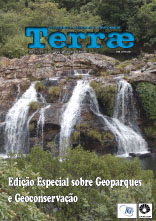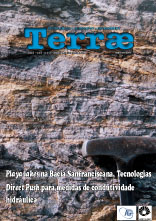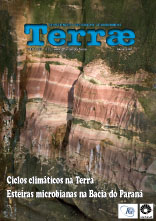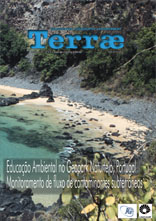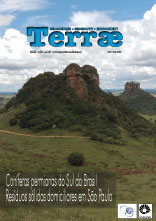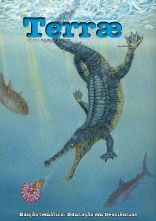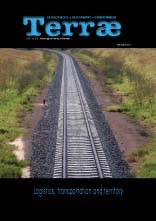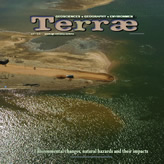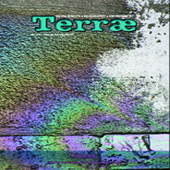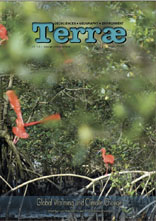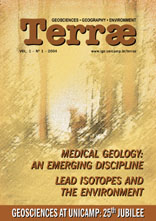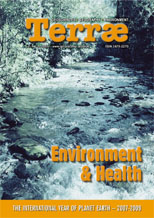Save the date / Call for papers
A revista Terræ publica simultaneamente as edições online de 2016 e 2017. As edições impressas acham-se temporariamente suspensas, pois os editores reconhecem que a internet oferece formas mais eficazes para disseminar rapidamente os resultados das pesquisas. As reformulações do periódico objetivam ampliar a abrangência, combinando redução de custos com rapidez de publicação. Cada vez mais a revista consolida a tendência de cobrir temas multidisciplinares que revelem formas de interação das Geociências com as diferentes áreas do conhecimento humano. A edição de Terræ 2017 é inteiramente dedicada ao tema GEOPARQUES.
A revista aceita trabalhos e comunicações em Português, Inglês e Espanhol.
Chamada de trabalhos / CALL FOR PAPERS
Uma vez recuperado o tempo de ausência na web, a edição de Terræ 2018 tornar-se-á uma boa opção para publicação de artigos científicos. O volume deverá reunir contribuições referentes a GEOÉTICA, tema que permite acomodar abordagens diferenciadas que revelem as inter-relações entre a sociedade e os ecossistemas terrestres.
O sistema de submissão e avaliação de artigos científicos está em pleno funcionamento, sendo feito exclusivamente pelo E-mail: terrae@ige.unicamp.br. Nosso sítio web está à sua disposição.
Esperamos sua visita e participação!
Os editores.
10/01/2018- 16:31 pm
Chamada de trabalhos/ Call for papers para o Volume 15, 2018
Novas contribuições são aceitas para o volume 2018 de Terræ.
Data limite 30.abril.2018
10/01/2018- 16:31 pm
Chamada de trabalhos/ Call for papers para os eventos:
VIII GeoSciEd 2018 – the 8th Quadrennial Conference of the
International Geoscience Education Organisation (IGEO)
– Geosciences for Everyone –
VIII Simpósio Nacional de Ensino e História de
Ciências da Terra / EnsinoGEO-2018
– Geociências para Todos –
Campinas – Sao Paulo – Brazil, July 2018
Acesse o site: http://www.ige.unicamp.br/geoscied2018/en/.
Data limite 11.fevereiro.2018
11/01/2018- 13:40 pm
Livro "Geologia do Brasil”, 2012: Reserve já seu exemplar, sem despesas de remessa.
Visite o endereço eletrônico: www.editorabeca.com.br
Os editores
Campinas, janeiro de 2018.
Evidence for a Plate Tectonics Debate
Asit Choudhuri
Institute of Geosciences – UNICAMP
Earth Science Reviews, 2001, 55:235-336
Prof. MacKenzie Keith – Department of Geoscience
Pennsylvania State University, USA
There is a story by José Saramago, the Nobel Prize winner for literature in 1999, in which the Iberian Peninsula breaks from mainland Europe and floats away. In essence, this is how landmasses may have split and broken away from a larger piece in the geological past, millions of years ago.
Although our planet Earth has been around
for more than four billion years, in our vision it would never be the same after 1912. In that year, Alfred Wegener, a German astronomer and meteorologist, often on scientific expeditions to Greenland, first proposed that the continents had drifted apart from what was a supercontinent. He read his hypothesis at the Geological Society in Germany, and this was the beginning of the idea of continental drift, or Kontinentalverschiebung in German. Alfred Wegener was a "drifter". Although elegant and interesting models of continental drift have been proposed since then by well known geologists, such as Arthur Holmes, Du Toit, and Sam Carey, the idea met with strong opposition among earth scientists, particularly in North America, till such time as the discovery of "ocean-floor spreading" paved the way for the theory of plate tectonics. We have now become so used to this theory that its drawbacks and faults have seldom been questioned.
In his seminal paper in 1993, with the thought-provoking title Geodynamics and mantle flow: an alternative earth model (Earth Science Reviews, 33, 153-337), Prof. Keith challenges the very foundation of the plate tectonic model. If we take a look at the list of references in his paper, it turns out that he took more than 15 years of research before taking this bold step. He underscores the fact that those in favor of the plate tectonic model try to fit Nature into it instead of the other way about. His strong and convincing arguments are based on evidences of geophysical anomalies, heat flow, properties of materials, petrology, and geochemistry. His recent paper, cited above, is also in the same tone, and he shows that, with a wealth of geophysical evidence, and the fact that deep continental roots have existed since the Archaean, we can no longer think of a conventional hypothesis of rigid plates moving around. Although both his papers are heavy reading, they deserve our attention, to say the least. There is so much substance in them that it is almost impossible to assimilate all that he has to say in one reading.
Just as it was difficult in the past to accept continental drift, today it is more than inconvenient if someone comes along and challenges the plate tectonic model. It is clear that it is not easy to modify or even abandon theories that find the support of the majority in spite of their glaring defects, and we should do well to remember a line quoted in Prof. Keith’s paper: The mind lingers with pleasure upon facts that fall happily into the embrace of the theory and feels a natural coldness toward those that seem refractory - T.C. Chamberlain - 1890.
Perhaps we should reflect on the following words of Richard Feynman, Physics Nobel Laureate: If you set up a theory and publish it, then you must not only point out the facts that agree with it, but also all that there is that doesn’t agree with it.
A PDF reader is required to view the article files. Make the download here: Adobe Acrobat or Foxi



